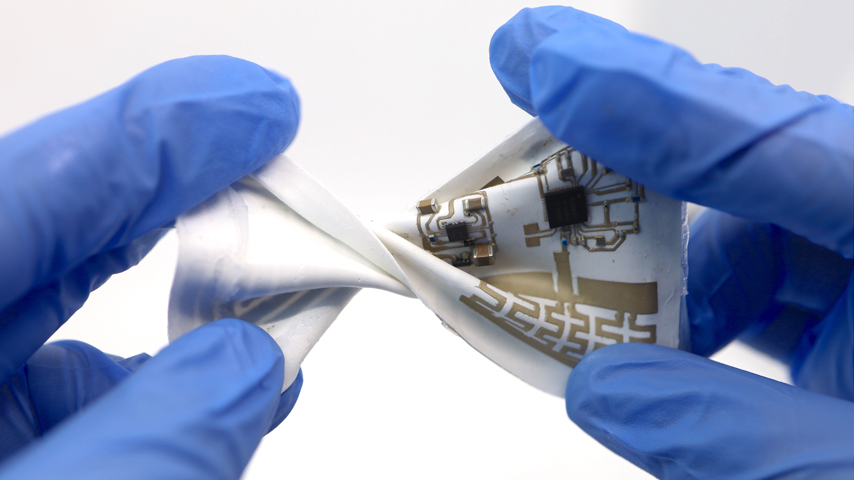Stretchable Material Mimics Skin, Boosts Signals
Stretchable Material Mimics Skin, Boosts Signals


A newly developed material substrate can adjust its dielectric properties to counter the disruptive effects of motion on interfacing electronics.
A multidisciplinary team of researchers at Rice University and Hanyang University in South Korea has developed a material that flexes just like skin while preserving the signal strength of the electronics within, which could offer improved signal possibilities for biomedical devices and other wearables.
This two-year endeavor brought together researchers specializing in mechanical and electrical engineering with expertise in antennas, electromagnetics and mechanical simulation, biomedical fabrication, and more.
“Our team was able to combine simulations and experiments to understand how to design a material that can seamlessly deform like skin and change the way electrical charges distribute inside it when it is stretched so as to stabilize radio-frequency communication,” said Raudel Avila, assistant professor of mechanical engineering at Rice and a lead author on the study. “Strain-invariant stretchable radio-frequency electronics,” published in May in Nature. “In a way, we are carefully engineering an electrical response to a mechanical event.”
It’s in the substrate
Although the development of new wearables has come a long way over the past few decades, the team initially began to wonder about the problems and limitations that materials embedded with electronics often encounter, especially since these materials are often mechanical on one side and electrical on the other.
Typically, the goal is to minimize the geometrical transformation within electronics in order to maintain the electrical system’s stability, Avila explained. “But that would only get you so far, because at some point the deformation is going to be too large,” he continued. “So, we started to think a little bit about some areas that were unexplored, which was the substrate itself.”
You Might Also Enjoy: Electronic Skin Sends Sensations to the Brain
Avila’s team began to explore the possibility of engineering the substrate to be mechanically stretchable, with the functionality of stabilizing the resonance frequency—that way an electronic device would be able to perform no matter how much it moves or changes shape.
“The idea was, can we have two competing physics acting at the same time where you have the mechanical strength on one end, but also an electrical response on the other end, where you're kind of cancelling each other out so that your resonance frequency, when you're communicating or sending information, remains stable,” he continued.
What makes this possible is combining two materials to make a new one: by embedding highly dielectric ceramic nanoparticles into a soft elastomer with high stretchability. These clustering sphere-like arrangements of nanoparticles will change shape when mechanical force is applied.
“Because of that, you're going to have these changes that translate into the electrical field, and then eventually, to the dielectric response of your material,” Avila said. "Since you have two materials that are different, one of them is soft and has a low dielectric constant, and the other one is rigid but has a large electric constant, when you stretch them, you have a sort of tunability. That tunability comes from the response of the individual constituents inside that material. Then we have that dielectric response, which is useful now to stabilize electronics.”
Become a Member: How to Join ASME
Additionally, the team reverse-engineered the material so that it would be able to move and stretch like skin, while also being able to adjust its dielectric properties, thus limiting the effects of motion on interfacing electronics.
“This is a new application of these materials in the sense that in the past, you had antennas or these kinds of electronic circuits that were engineered in a way that assumed there would be a substrate that we can use. Then you just move away from the substrate and engineer the components,” Avila explained. “But in this case, you are not only engineering the antennas, but you're also engineering the substrate itself in a way that gives you additional freedom in how you can design these electromagnetic systems.”
Possibilities
During testing, the team built multiple wireless devices—an antenna, coil, and transmission line—using both the new material and one that had an unaltered elastomer.
“When we put the electronics on the substrate and then we stretch or bend it, we see that the resonant frequency of our system remains stable,” Avila said. “We showed that our system supports stable wireless communication at a distance of up to 30 meters, even under strain. With a standard substrate, the system completely loses connectivity.”
More on Materials: New 3D Printing Method Cuts Material Development Time in Half
This marks a significant improvement over other skin-interfaced systems that have been developed to date, according to the team.
For now, the researchers are focusing mostly on possible use of this material in wearable biomedical devices and soft robotics—anything that has an interaction between electrical and mechanical systems while also needing to move and change shape.
“I think this is a great first step or introduction to this area where we have competing physics within systems,” Avila said. “We need to continue to explore that area and have this new material available for new applications and develop a little bit more of a robust framework.”
Louise Poirier is senior editor.






